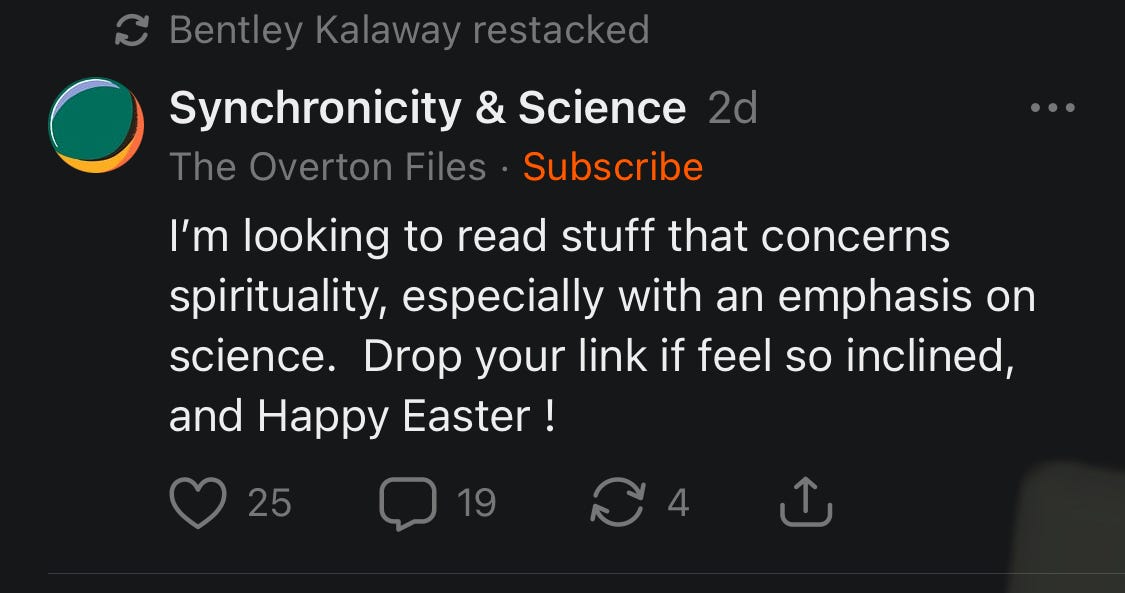Greetings friends and wisdom-lovers, and welcome to the Wisdom Workshop, a newsletter and learning community for people who want to live lives worth examining.
Play is one of the key aspects of living a good life — a life that is both fulfilling and morally upright. For Schiller (1795), Huizinga (1938), Carse (1986), and Brown (2009), play is essential to human flourishing. In the Brahma Sutras (~200 BC), the universe is lila, or “divine play.”
One of the deeper ways I’ve found to play is to pay attention to synchronicities — the meaningful coincidences that somehow blend my inner and outer worlds. “Pay attention to what you pay attention to,” may be the most profound invitation to our freedom.1
With big thanks to the eighteenth cohort of Writing the Good Life, here’s some quotes, links, and invitations for experiencing more synchronicity and enjoying more serious playfulness.
"The universe is full of magical things patiently waiting for our wits to grow sharper."
— Eden Phillpotts
Do You Believe in Synchronicity?
I do. I think of a friend, and they call. Or I open up a book to the exact passage I didn’t know I needed. Or I take a break from writing this essay, and the top note in my feed, from a profile I’ve never seen before reads:
For Jung, who coined the term, synchronicities are meaningful connections where, in a moment in time, the outer world somehow reflects the inner mind2.
If you’ve ever consulted the I Ching, or gotten your cards read well, you may have had an uncanny experience that somehow, the universe was speaking to you.
In the context of life design, synchronicity comes up with regard to wayfinding: figuring out where we’re going when we’re lost — in the woods or in our existences.
Like its cousin serendipitiy — synchronicity is a skill of paying attention to what we notice — and then seeing (or making?) more meaningful connections.
Synchronicities have helped me integrate my experience with more meaning and mystery. As a writer, paying attention to synchronicity is an authorizing function. It’s like permission to write bad poetry.
Considering synchronicity as a set of skills — rather than something that happens to you — has imbued my life with greater wonder, awe, and connection. I’m a believer.
Syncrhonicities are also loads of fun to look for, while they’re useful to navigate uncertainty. So:
Can we learn to train our attention on "the thrill of unexpected discovery?"3
Can we learn to see (or make?) meaningful connections where others might not?4
Can we learn to become “super-encounters” together?5
That sounds pretty neat. I hope this helps.
Synchronicity Skillsets: The R.E.M. Framework
Or: How to Become a Super-Encounterer

In “Engaging with Life: Synchronicity Experiences as a Pathway to Meaning and Personal Growth” (Current Psychology, 2022), Pninit Russo-Netzer and Tamar Icekson offer a framework for a how to practice synchronicity. It’s REM: Receptivity, Encounters, and Meaning-Making.
R: Receptivity
Super-encounters expect the extraordinary. While we “count on finding treasures in the oddest places,” we also expand our circumferences of luck6. We engage in new conversations, take different routes to work, use our attention in engaged ways. We can appreciate George Costanza, when he decides to do everything the opposite way he would normally do it. We can cultivate a beginners mind. As we frame our experiences with radical curiosity, we can train our attention to notice the significant. That leads us to . . .
E: Exceptional Encounters
We find the extraordinary in the seemingly ordinary. The more we pay attention, the more we position ourselves to notice the exceptional, the salient, the wildly coincidental in an unexpected email, a surprising ping, or an obviously coincidental phone call from a friend. We can listen intently. We also believe in ourselves, and we authorize the importance of what we notice. When we believe we are good at experiencing synchronicity, we authorize more exceptional encounters.
M: Meaning Making
We are meaning-making animals, and when we make meaning with situational cognizance, we’re wayfinding. Just as keeping a gratitude journal helps us find more to be grateful for, taking formal notice in a synchronicity journal helps us make meaning from synchronicity streaks. This, in turn, helps prime our beliefs in ourselves as super-encounterers, which helps us make meaning from the connections we notice.
What’s Play Got to Do with it?
Eight Play Personalities
“Man only plays when he is in the fullest sense of the word a human being, and he is only fully a human being when he plays.”
— Frederich Schiller (NA XX, 359/E 131), qtd. in the Stanford Encyclopedia of Philosophy, and also showed up in The Art of Fielding by Chad Harbach
Play, of course, is not just for children. Play helps us prefrontal cortex-heavy human beings continue to grow throughout our adult lives. Play takes many forms.
▢ We engage in play for its own sake,
▢ We enjoy playing,
▢ We would continue playing, if we could, and
▢ Play might alter our normal perceptions of self and time.
At work, a sense of play nourishes us as we go along. Play can prevent burnout and can help us innovate new processes. Play fosters human connections, generates new neural networks. Play helps us imagine new ways of being with ourselves, our peers, and our worlds. Play can help us reset, relax, and re-calibrate. Play can help us re-create ourselves. Lila indeed.
In the context of life design, play can help us tap into new potential futures.
So serious play is serious business, with clear benefits to our professional and personal lives — and even clearer benefits to our mental health. “The opposite of play isn’t work,” Stuart Brown writes, “it’s depression.”
Which Play Personality Are You?
Stuart Brown, MD, is the founder of the National Institute for Play. He has taken the “play histories” of over 6000 people, and in so doing, he’s noticed eight general archetypes, or play personalities.
Before you read them, though, it might be fun to stop and reflect: How do you play? How do you integrate play into your work? As a child, how did you play? What games did you like most? If you’re able, you might interview your parents and ask the same questions: how did we play when we were kids?
Which play personalities seem like you?
Which personalities might you like to play with?
How might your play personality help you encounter more synchronicities?
:::::::::::::::::::::::::::::::::::::::::::::::::::::::::::::
1. Explorers
Explorers love adventures and expeditions. Their journeys might be physical, emotional, and/or mental. Explorers have an enthusiasm for discovery: for new points of view, new relationships, and or new experiences.
2. Competitors
Competitors play to win. Competitors need to know the rules, and have a lot of fun keeping score and rising to the top in their fields. Competitors play games that can be social or solitary in nature… but we competitors love to compete.
3. Directors
Directors like to orchestrate and execute complex situations and events. Throwing parties, organizing meetings, directors love the power and the thrill of putting people and things into places that makes something great.
4. Collectors
Collectors love to assemble and gather things or experiences. Collectors find what is interesting about coins, cards, or vacation spots. Collectors develop excellent taste, and may or may not have a showroom, cabinet of curiosities, or well-stocked shelves.
5. Artists / Creators
Artists find joy in making things, in creating something where there wasn’t something before. These creations may be functional or funky, architectural or ephemeral. Wood-working, music-making, and gardening included.
6. Jokers
Some people call them space-cowboys. Some call them gangsters of love. Jokers have been revered in history as tricksters, noble fools, and powerful truth-tellers. Jokers might be accused of being nonsensical, but they know how powerful nonsense can be.
7. Athletes / Dancers
Athletes/Dancers are at their best when they’re moving and engaging their physical body. They might like playing physical games, but for dancers, the joy isn’t really in the winning — it’s the feeling of dynamic embodiment. Dancers move to think.
8. Storytellers
Storytellers cherish the imagination, and partake in narrative arcs more than most. Storytellers can find elements of plot and character where others do not. They have the power to transform the mundane with imaginative flights of fancy.
Acknowledgements
Thanks to Stuart Brown, MD, and his marvelous book Play: How it Shapes the Brain, Opens the Imagination, and Invigorates the Soul (Penguin, 2009). Thanks to Bill Burnett and Dave Evans at Stanford, and Julia Cameron in the American Southwest. Thanks to Serendipitous Informtion Systems researcher Sandra Erdelez, PhD, who coined the term “Super-Encounterer.”
Bigger thanks to the those synchronous souls Writing the Good Life with me. Also thanks to Joan Ball, Maya Ortega, and John Giordano. Meaningful connectors each.
Thank you free and paid subscribers! Welcome Justin!
Acknowledging the first stewards and peoples of this land — the traditional territories and ancestral homelands of the Cheyenne, Arapaho, Ute, Apache, Comanche, Kiowa, Lakota, Pueblo and Shoshone Nations, and the 48 contemporary tribal nations historically tied to the lands that comprise what is now called Colorado.
Thank you for reading!
Wishing us well into the extraordinary ordinary,
Sean
Experiencing any synchronicities? Wanna jam about creative lifelong learning with me?
👋 May 2025 Invitations
First Friday, May 2 at 1:30-2:30pm MST. Facilitation Lab Open House. Zoom7. How do we facilitate flourishing in groups? Mindful writing, loving kindness, and perspective.
First Monday, May 5th at 1:00-2:00pm MST. Mindful Writing Open House. Zoom8. We’re celebrating Beltane with writing/sharing for presence, purpose, and playfulness.
Week 3 of Writing the Good Life
Below, you’ll find Invitations 15 - Invitation 21 on Wayfinding with Playfulness.
Overview: Wayfinding with Playfulness
In the third week, we follow the lead of Stanford Design Lab, and add in the play of serendipitous synchronicity. Using our dashboard and compass, we’ll explore wayfinding, synchronicity, and play. Wayfinding: “the ancient art of figuring out where you’re going when you don’t actually know your destination.” (Burnett and Evans) We’ll begin to fill in our maps; we’ll begin to open our experience to other traveling companions/helpers, and other tools and tech we might need for our journey.
Invitations to Read, Listen, and Authorize Deep Play
📘Burnett & Evans, Designing Your Life
Chapter 3: Wayfinding
Chapter 4: Getting Unstuck
Chapter 5: Prototype Conversations
Chapter 9: Choosing Happiness
📕Julia Cameron, The Artist’s Way
Chapter 3: Power
📄 Pagan Kennedy, “Cultivate the Art of Serendipity” in the NY Times (2016).
📄 Greg Levoy, “Synchronicities: A Sure Sign You’re on the Right Path” in Psychology Today (2017).
📄 Mark de Rond, Moorhouse, & Rogan, “Make Serendipity Work for You” in Harvard Business Review (2011).
📄 Pninit Russo-Netzer & Tamar Icekson, Engaging with Life: Synchronicity Experiences as a Pathway to Meaning and Personal Growth” in Current Psychology (2002).
▶️ Sean Waters How To Have a First-Rate Second Childhood: Stoicism and Aging Wisdom Workshop YouTube (2022).
▶️ William B. Irvine's Older and Wiser: Ancient Advice on Aging Well. Center for Values in Medicine, Science, and Technology YouTube (2012).
✍️ Invitation 15: Wayfind with A “Good Times” Journal
Keep reading with a 7-day free trial
Subscribe to Wisdom Workshop to keep reading this post and get 7 days of free access to the full post archives.







